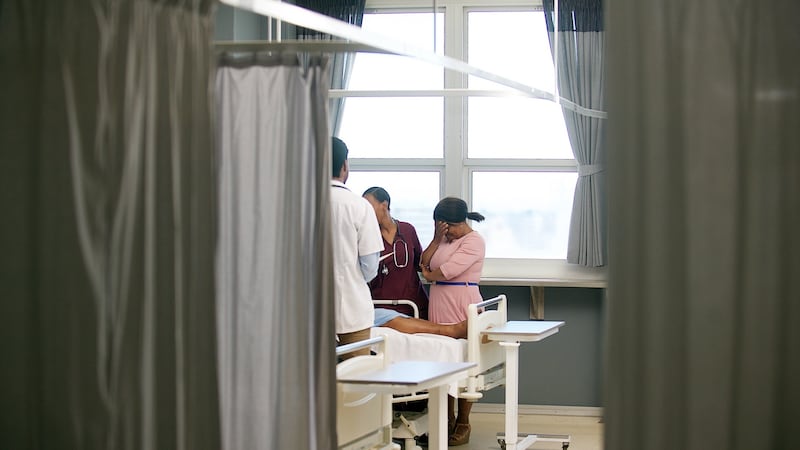“How people die lives on in the memory of those who live on.” – Dame Cicely Saunders, founder of the modern hospice movement.
Do you know what dying looks like? Do you want to know?
A lot of people are afraid of death and dying, yet like birth, it is one of life’s most natural processes. We don’t talk about it, but it happens to us all, and if we are very lucky, it occurs at the end of a long and happy life.
For many who fear death it is perhaps the fear of the unknown that is most terrifying, and it is that fear that Dr Kathryn Mannix, former palliative care physician, author and full-time campaigner for better public understanding of dying, is working to ease by encouraging us all to "narrate dying".
Speaking to The Irish Times, Dr Mannix said that after 30 years in palliative care she found she was having the same conversations with unprepared families and terrified people with terminal illnesses, whose image of dying came only from television and films which did not reflect reality. She said people generally, had no idea what the “normal, relatively predictable and usually, fairly comfortable process dying is actually like”.
She recalled meeting the adult retired sons of a father in his late 90s who was dying and none of them knew what their father’s wishes were. She described them as “panic-stricken” when asked how or where their father wished to die. A number of the sons who were in their 70s, confessed that their father had in the past tried to share his wishes for the end of his life with his sons, but they refused to discuss it and jokingly admonished him for being morbid.
“This made me realise that we can’t keep doing this to our families,” Dr Mannix said. “This is a national public health problem. In fact, it is an international public health problem that people in parts of the world that have highly developed and sophisticated and accessible to everybody medicine, have forgotten what normal dying looks like.”
Planning for death
According to Dr Mannix, nowadays the tendency in modern health systems to call an ambulance to bring everyone who is very sick and may die, to a hospital full of technology that might just save their lives, which, she acknowledged was wonderful if it worked, meant that nobody knows what normal death looks like. “So now nobody knows what dying is like. Everybody is terrified, nobody is talking about it, everybody thinks they know what it’s like, and everybody thinks it is awful. And actually, if they were less afraid, they would be able to sit down and have those conversations and plan better and die better,” she said.
Instead of putting off what may seem like a difficult conversation until it is too late, Dr Mannix suggested that we should all know more about dying and start planning for our own deaths while we are well. “We should all be thinking about how we would like our dying to be, where, who would be our companions,” she said.
She added that these plans can be tweaked with time and suggested that we should be having these conversations around any birthday that falls on the five times table after the age of 50.
Dr Mannix explained that like birth, which starts with labour pains and progresses through a predictable sequence of events, the process of dying also involves an anticipated sequence of events that are very similar from one person to the next, irrespective of what they are dying from.
“Just like every woman who has ever given birth to a baby feels she has had a particular unique experience, every midwife who has attended that woman has been through the same process that she always has. Because it’s the individual who makes it individual, it is not the process . . . every person who is dying is having their own unique, individual, personal family experience but those of us who are caring for them are seeing the same sequence of events time after time,” she said.
Steps of process
When Dr Mannix meets a patient who expresses a fear of being in pain or distressed when they die, she gently asks if they would like her to explain the process of dying to them and tells them that if they find it too distressing, they can ask her to stop at any time.
Nobody has ever asked Dr Mannix to stop.
She said that when people learn what really happens when we die, they don’t find it terrifying, on the contrary they see it as compelling and comforting.
“I tell somebody and then there is a long pause, usually when I dry my eyes . . . and then they say ‘That’s not what I was expecting, can you tell my wife that? Can you tell my dad that, can you tell my kids that?’ and, ‘That’s wonderful I want my family to know it will be a comfort’.”

Dr Mannix explained that at the end of our lives we simply get more tired and need to sleep more.
As the illness state advances and death becomes closer, the periods of being awake get less and the periods of sleep get longer. Eventually, she said there comes a time when a patient is so deeply unconscious that they cannot be woken. When they do wake up later on, they report that they had a good sleep. Therefore, Dr Mannix said we know that being unconscious is not unpleasant for people.
She explained that when a person is unconscious, medical staff can continue to give them their regular medication to help ease the symptoms of their disease, such as breathlessness or pain, via an injection or syringe pump rather than in tablet form.
“They sleep more, they are awake less. We change the route of the medicines, but it isn’t the medicines making people sleep, it’s the illness, it’s the process of dying and at the very end of people’s lives they lapse into unconsciousness,” she said.
Unconscious state
Dr Mannix explained that this unconsciousness doesn’t feel like falling asleep and the person is not aware that it is happening.
Once the person is completely unconscious the only part of the brain that still functions is that which drives breathing which then becomes completely automatic.
She explained that at this point a person’s breathing alternates between cycles of deep and shallow breathing.
She also pointed out that in this deeply unconscious state, the dying person is not aware of their vocal cords. However, when they breathe out through their vocal cords it can make a noise and family members may fear that this is the sound of their loved one groaning or sighing in distress.
The so-called “death rattle” people hear can also be explained. This too is all part of the dying process and occurs because the dying person is so unconscious that they can no longer cough or swallow to clear normal secretions like saliva or mucus from the back of their throat.
“We would normally cough or splutter or gag if anything is touching the back of our throat because it is a reflex to preserve our lives. Once you are deeply unconscious, all of those sensations are just lost and we tolerate that . . . because you are breathing, the air is going in and out, it makes that funny clicking noise that you would normally never hear in any other circumstances because, in any other circumstances people would clear their throat,” she explained.
Dr Mannix said it was important to remind families that this was automatic breathing because when someone is deeply unconscious, they cannot feel distress.
“As time goes by the breathing gets slower, there are pauses and then eventually there will be an outbreath which doesn’t seem any different to any other out breath, but there just isn’t an inbreath afterwards. It’s as gentle as that.”

According to Dr Mannix, 100 years ago we would never have spoken about childbirth in public, but we would have all known about dying and she believes it is time for lay people to reclaim death and dying.
Death bed
While Dr Mannix acknowledged that GPs, community nurses and palliative care specialists would always have a role in the dying process, to help ease symptoms and ensure that the person is as comfortable as possible, she said that dying was not a medical matter but rather a social one.
Therefore, she was appealing to medicine to “give dying back to everyone”. “People will only understand what is happening around the death bed if we narrate it,” she said.
By helping grieving families understand the dying process, this will allow them to take the comfort of witnessing their loved one experience normal, gentle dying into their bereavement with them, Dr Mannix said.
“You can’t stop it from being sad. If we love people, then death is a terrible blow – it is a very great sadness. But we can stop it from being terrifying. We can give people the knowledge that they need to be with people who are dying.”
Dr Mannix’s book With the End in Mind: Dying, Death and Wisdom in an Age of Denial was shortlisted for the 2018 Wellcome Book Prize and she is one of a number of speakers due to address the annual dotMD conference which takes place in Galway in September.
Hailed as a festival of medical curiosity and known by some as the Electric Picnic of medical conferences, dotMD is a celebration of the heart of medicine. dotMD is curated by Dr Ronan Kavanagh, consultant rheumatologist; Dr Muiris Houston, GP and medical journalist and writer; and Dr Alan Coss, consultant gastroenterologist.
The purpose of this highly popular event which, for the first time in its seven-year history is taking place outside Dublin, is to expose doctors, medical students and other healthcare professionals to the ideas taking place at the interface between medicine, the humanities and technology.
Themes included in this year's two-day dotMD meeting in Galway on Friday, September 13th and Saturday, September 14th, include, jazz, death, art, stories and zombies.









